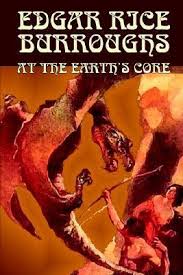Chapter VIII — At the earths core
byChapter VIII opens with the protagonist grappling with both survival and a new encounter that could shift his fate. After a deadly clash with a reptilian predator, he unexpectedly meets Ja, a native of Pellucidar’s island tribes. Their initial mistrust fades as they slowly piece together a shared language, using gestures and basic words to build communication. Ja, curious but cautious, shares stories of his people—the Mezops—who live in treetop dwellings and practice a delicate balance between fear and diplomacy with the ruling Mahars. The Mezops’ way of life revolves around strict codes, communal respect, and tactical alliances that help them endure in a harsh environment. The protagonist listens intently, fascinated not only by the cultural richness but also by the resilience hidden within such a primitive setting. Their journey toward Ja’s village reveals a peaceful society living under constant threat, yet never fully surrendering to it.
As the path leads deeper into Mezop territory, the protagonist observes the ingenious layout of their elevated trails and homes. Everything is built with purpose—crafted to defend, shelter, and unify. Children play high in the branches while elders trade stories by torchlight, their lives suspended above danger. It’s a striking contrast to the chaos he’s endured since arriving in Pellucidar. Ja explains that the Mezops use these trails to navigate quickly and quietly, especially when threatened by Sagoths or Mahars. Trust grows between them as the protagonist respects the tribe’s resourcefulness and quiet strength. Yet, he senses the shadow looming over their harmony: the Mahars’ control extends even here. The Mezops maintain their freedom through a truce, offering tribute in exchange for limited interference—a fragile peace never fully guaranteed.
Curiosity drives the protagonist to follow Ja to a nearby Mahar temple—an ancient, circular structure carved into the mountain rock. Despite Ja’s warnings, he ventures too close and is drawn into the eerie rituals of these cold-blooded overlords. Hidden among stone walls, he watches in horror as humans are hypnotically led into the temple’s heart, only to be sacrificed in silence. The Mahars do not kill out of need but from a strange fascination with power and submission. Their victims remain eerily calm, dazed by the Mahars’ psychic abilities, making resistance impossible. It becomes clear that domination here is not just physical—it’s psychological. The protagonist, struggling to process the horror, realizes that he has fallen deeper into the heart of darkness than ever before.
A sudden misstep lands him into the Mahar’s ceremonial pool—a vast basin used in their gruesome rites. Panic rises, but instincts take over. He thrashes free of the water and finds a narrow passage that leads him out of immediate danger, though still within the bounds of the temple. Whether spared by accident or design, he can’t know, but his narrow escape feels like borrowed time. In the temple’s silence, he stumbles upon a hidden chamber containing old relics and a stone altar marked with strange glyphs. These discoveries suggest that the Mahars’ cruelty may have religious or ritualistic roots, deepening the mystery of their civilization. Alone and breathless, he now understands that knowledge in Pellucidar can be more dangerous than any creature.
By the time he reunites with Ja, his mind races with the implications of what he’s seen. The Mezops, for all their balance and ingenuity, remain vulnerable. The Mahars possess a grip on Pellucidar not just through strength, but through fear and myth. He confides in Ja, who listens gravely and offers both counsel and caution. Together, they begin to map a broader path—not just for survival, but for resistance. For the first time, the protagonist sees that the only true escape from Pellucidar’s dangers may be found through unity and rebellion. This realization marks a turning point—not only in his journey, but in his understanding of this world’s interconnectedness.
This chapter immerses readers in the coexistence of wonder and brutality that defines Pellucidar. Through meaningful alliances and shocking revelations, the protagonist is forced to grow—not just as a survivor, but as someone awakening to his role in shaping this world’s future. He is no longer just an outsider trapped underground. He becomes part of a story greater than his own, one where every step forward could spell either progress or doom. In that tension, the heart of the chapter pulses—equal parts dread, discovery, and the possibility of revolution.

